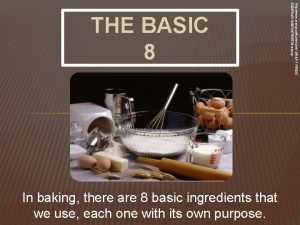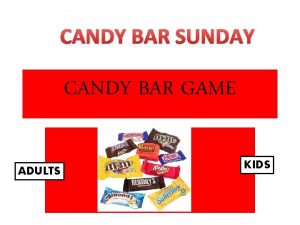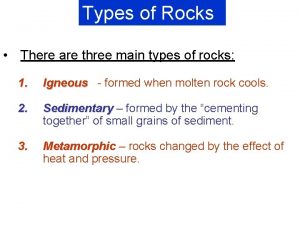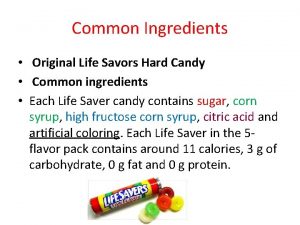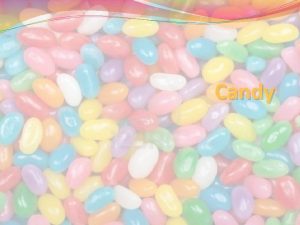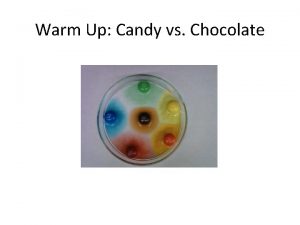CANDY COMMON CANDY INGREDIENTS There are two main





























- Slides: 29

CANDY!!!!!

COMMON CANDY INGREDIENTS There are two main factors that affect the taste of your candy: the ingredients you use and the procedure you follow. By educating yourself about common candy ingredients such as chocolate and sugar, and by selecting the best ingredients you can find, you will go a long way toward ensuring successful, delicious candy.

A GUIDE TO SUGAR Granulated sugar: This is derived from either beets or sugarcane, and when a recipe calls for “sugar” or “white sugar, ” it is referring to granulated sugar. Brown sugar: This is granulated sugar with molasses added. It comes in “light” and “dark” varieties; light brown sugar has a milder flavor and is usually recommended for candy making. Brown sugar should be packed down in a measuring cup while measuring. Generally, brown sugar should not be used to replace other sugars. Superfine sugar: Also called caster sugar. This is granulated sugar with a very fine texture. It is useful when making candy centers because it dissolves quickly and doesn’t produce a grainy texture. Superfine sugar can be used in place of regular granulated sugar without adverse results. Powdered sugar: Also called confectioner’s sugar or icing sugar. This is very fine-textured sugar with cornstarch added; it needs to be sifted before use. Do not use powdered sugar to replace any other sugars in candy recipes.

A GUIDE TO SUGAR Corn syrup: Also known as glucose. Corn syrup is produced from cornstarch and comes in “light” and “dark” varieties; in confectionery light is generally preferred. Corn syrup prevents other sugar from crystallizing and makes cooked candies firmer, so is often used in cream fillings and fudges. Invert sugar: Liquid sugar. It improves the shelf life of many candies. Only use invert sugar if a recipe specifically calls for it. Honey: Any mild bee’s honey can be used in recipes that call for honey. The honey should be liquid, not of the “creamed” or “honey spread” varieties. Molasses: A by-product of the sugar refining process, it is a thick dark syrup with a distinctive taste.

A GUIDE TO CREAM Half and half: half milk and half cream mixed together, with a fat content between 10 -15%. It adds a richness milk does not, but is not thick enough to replace cream in recipes that call for cream. It will not whip like cream, either. Light cream: fat content between 18 -30%, also known as coffee cream. Light cream will not whip. Whipping cream: made specifically for whipping, contains 30 -36% milk fat. Often contains stabilizers and emulsifiers to ensure it keeps and holds its form when being whipped. Heavy cream: also called heavy whipping cream, has a fat content between 36 -40%.

A GUIDE TO CREAM Manufacturing cream: has a fat content over 40%, and is generally not available in retail stores. It is primarily used in professional food service. Aerosol cream: comes in aerosol cans and contains cream, emulsifiers, stabilizers, and nitrous oxide, the propellant used to squirt it out of the cans. Although it has its uses in dessert preparation, it is not used in candy making. “Whipped topping” or “dessert topping”: usually does not contain cream at all, but instead is a mixture of hydrogenated vegetable oils.

HOW TO ROAST, SKIN, AND CHOP NUTS How to Roast: Hazelnuts: Hazelnuts are commonly sold with their thin, papery skins still on the nuts, so they need to be skinned before they can be used. The skins are not harmful, but their taste and texture are not desirable in candies or other baked goods. To skin them, first toast them by spreading the nuts in a single layer on a baking sheet. Bake them at 325 degrees until they give off an aroma, and their skins are brown and split. This should take about 7 -10 minutes, depending on the amount of nuts. � Check the nuts every few minutes while toasting, and shake or stir the nuts so they toast evenly. Remove them from the oven when they are fragrant and brown, and allow them to cool at room temperature. � Once they are cool enough to handle, rub the nuts between two clean kitchen towels. The skins will come off with the friction, leaving clean and toasted nuts. A small amount of skin remaining on the nuts is normal. �

HOW TO ROAST, SKIN, AND CHOP NUTS Almonds: Almonds are sold in various states of preparation: whole, sliced, or slivered, blanched or natural. � To skin whole almonds, drop them in boiling water and let them cook for 1 minutes, then drain the nuts and let them cool. � Once they are cool enough to touch, pinch the nuts between your fingers and the nuts will slide out of the skin. � To toast almonds, spread them in a single layer on a baking pan. Bake at 325 degrees until they are light brown and fragrant, about 5 -10 minutes depending on the amount of nuts. Check the nuts frequently and stir them to ensure even toasting.

HOW TO ROAST, SKIN, AND CHOP NUTS Other Nuts: To toast walnuts, pecans, pistachios, macadamias, and other nuts, follow the same procedure as for toasting almonds: spread them in a single layer on a baking pan. Bake at 325 degrees until they are light brown and fragrant, about 5 -10 minutes depending on the amount of nuts. Check the nuts frequently and stir them to ensure even toasting. Always cool your nuts before chopping them. Nuts have a great deal of oil that has been brought to surface by the heat, and the oil must be allowed to be reabsorbed, or the nuts could turn greasy during chopping.

HOW TO ROAST, SKIN, AND CHOP NUTS How to Chop Nuts For many nut candies, the recipe requires that the nuts be chopped. Depending on how finely the nuts should be chopped, this task can be done by hand or with a food processor. If a recipe calls for “finely chopped” or “finely ground nuts, ” it is easiest to use a food processor. Place a small amount of nuts in the processor, and pulse quickly several times. Nuts have a great deal of oil, so it is easy to over-process nuts and end up with nut butter if you are not carefully monitoring them. Do the nuts in small batches to ensure even chopping. If the candy recipe calls for simply “chopped nuts” or “coarsely chopped nuts, ” the nuts can be chopped by hand using a knife. First, gather the nuts in a circle slightly smaller than the length of the knife’s blade. Rock the blade back and forth, rotating it around the circle with a firm, quick stroke. Periodically stop and reposition any nuts that have shifted outside of the circle. Continue chopping in this fashion until the nuts are a suitable size.

A GUIDE TO CHOCOLATE VARIETIES Cocoa powder: This unsweetened powder is pulverized, partially defatted chocolate liquor. Cocoa powder gives an intense chocolate taste and is available in “Dutch-processed” (alkalized) or natural varieties. Natural cocoa powder is light brown, with a strong, pronounced chocolate flavor. It is slightly acidic, so it is best to use natural cocoa powder in recipes calling for baking soda. Alkalized cocoa powder is darker in color, less acidic, and has a milder chocolate taste. Alkalized cocoa powder is recommended for recipes that call for baking powder.

A GUIDE TO CHOCOLATE VARIETIES Unsweetened chocolate: Also known as “bitter” or “baking” chocolate. This is pure chocolate liquor, composed solely of ground cocoa beans. Although it looks and smells like chocolate, it has a bitter taste and is not meant for consumption on its own—it is best used in cooking, when it can be combined with sugar to make it more palatable. Because cocoa beans contain equal amounts of cocoa butter and cocoa solids, unsweetened chocolate lends a deep, rich chocolate flavor to baked goods. Unsweetened chocolate is the base ingredient in all other forms of chocolate, except white chocolate.

A GUIDE TO CHOCOLATE VARIETIES Dark chocolate: Chocolate that contains chocolate liquor, sugar, cocoa butter, vanilla and leicithin (an emulsifier). There are no milk solids added in dark chocolate. The cocoa content of commercial dark chocolate bars can range from 30% (sweet dark) to 70 - 80% for extremely dark bars. Bittersweet chocolate and semi-sweet chocolate also fall into the “dark chocolate” category.

A GUIDE TO CHOCOLATE VARIETIES Bittersweet chocolate: Chocolate that contains at least 35% cocoa solids. Most bittersweet bars contain at least 50% chocolate liquor, with some bars pushing 70 -80% chocolate liquor. This chocolate often has a deeper, more bitter flavor than sweet dark or semi-sweet bars. However, the amount of sugar in the chocolate is not regulated, so one manufacturer’s “bittersweet” bar may taste sweeter than another’s “semisweet” bar. Semi-sweet chocolate: This is primarily an American term, popularized by Nestle Toll House semi-sweet chocolate chips. Semi-sweet chocolate contains at least 35% cocoa solids, and is generally assumed to be darker than sweet dark chocolate, but sweeter than bittersweet.

A GUIDE TO CHOCOLATE VARIETIES Sweet dark chocolate: is “dark chocolate” in the sense that it does not contain milk solids, but it still has a high percentage of sugar and is much sweeter than other types of dark chocolate. Many brands of sweet dark chocolate have only 20 -40% cocoa solids. Milk chocolate: In addition to containing cocoa butter and chocolate liquor, milk chocolate contains either condensed milk or dry milk solids. Milk chocolate must contain at least 10% chocolate liquor, 3. 39% butterfat, and 12% milk solids. Milk chocolates are typically much sweeter than dark chocolate, and have a lighter color and a less pronounced chocolate taste. Milk chocolate is more difficult to temper properly and more prone to overheating.

A GUIDE TO CHOCOLATE VARIETIES White chocolate: White chocolate gets its name from the cocoa butter it contains, but does not contain chocolate liquor or any other cocoa products. As a result, it has no pronounced chocolate taste, but commonly tastes like vanilla or other added flavorings. By law, white chocolate must contain a minimum 20% cocoa butter, 14% milk solids, and a maximum of 55% sugar. "Candy coating" chocolate: Also known as “confectionery coating, ” “summer coating, ” or “compound coating. ” These terms refer to candy products that are flavored like dark, milk or white chocolate and substitute vegetable or palm oils for cocoa butter. These products are cheaper than most chocolates, and do not contain significant amounts of chocolate liquor; thus, they do not have a strong chocolate flavor or an appealing mouthfeel. However, they have excellent melting and molding properties, and thus are often used in candymaking for dipping or enrobing, since they do not require tempering and can withstand high ambient temperatures. Be careful to never mix candy coating with real chocolate, as the fats are not compatible and the resulting candy will be unattractive and discolored.

WORKING WITH SUGAR Candies that are based on a sugar syrup—sugar and water boiled together—often give instructions to boil the syrup to a specific temperature. To make these recipes, you will either need a candy thermometer, or will need to be familiar with the “cold-water method” of temperature checking. Additionally, some traditional recipes call for the candy to be “pulled, ” as in taffy or ribbon candy.

CANDY TEMPERATURE GUIDE Thread Stage: 223 -235 degrees The earliest candy temperature stage is Thread Stage. At this temperature, the syrup drips from a spoon and forms thin threads in cold water.

CANDY TEMPERATURE GUIDE Soft Ball Stage: 235 -245 degrees The syrup easily forms a ball while in the cold water, but flattens once removed from the water.

CANDY TEMPERATURE GUIDE Firm Ball Stage: 245 -250 degrees The syrup is formed into a stable ball, but loses its round shape once pressed.

CANDY TEMPERATURE GUIDE Hard Ball Stage: 250 -266 degrees The syrup holds its ball shape and deforms only slightly with very firm pressure, but remains sticky.

CANDY TEMPERATURE GUIDE Soft Crack Stage: 270 -290 degrees The syrup will form firm but pliable threads when removed from the water. Many different recipes require cooking candy to soft-crack stage, commonly including toffees, brittles, and butterscotch. Often, candies that are cooked to soft-crack stage feature a caramelized sugar flavor and a hard, pleasingly crunchy texture.

CANDY TEMPERATURE GUIDE Hard Crack Stage: 300 -310 degrees The syrup will form brittle threads in the water, and will crack if you try to mold it.

CANDY TEMPERATURE GUIDE Caramel Stage: 320 -350 degrees The sugar syrup will turn golden at this stage. Honey colour produces a light caramel, while amber is a darker, fuller caramel. Anything darker than amber will result in a slightly burnt taste.

WORKING WITH CHOCOLATE After sugar, chocolate is probably the most common candy ingredient, so it is important to know how to successfully work with chocolate. If you make a mistake while working with chocolate —and who hasn’t? —there also solutions and suggestions for salvaging your chocolate.

MELTING CHOCOLATE Melting chocolate can be accomplished in a microwave or over a hot-water bath. There a few fundamental guidelines to successfully melting chocolate: Make sure the chocolate is chopped into uniform pieces to ensure even melting. Never try to melt large bars or blocks of chocolate that have not been chopped. Avoid all contact with water! Chocolate will seize and become unworkable if it comes into contact with even a few droplets of water. Make sure your bowls, workstation, and spatulas are completely dry. Melt the chocolate slowly over low heat. Chocolate is very delicate and can become lumpy or grainy if overheated. Stir the chocolate frequently with a rubber spatula, once the outer edges start to melt. Chocolate retains its shape when melted, so the only way to know if it is truly melted is to stir it. Do not rely on appearances alone.

MELTING CHOCOLATE Melting Chocolate With a Double Boiler The traditional method of melting chocolate is to use a double boiler. A double boiler is a specialized set of pans consisting of a saucepan that holds hot water, and a bowl that fits securely over the saucepan. Chocolate is placed in the top bowl and allowed to melt over gentle, indirect heat. If you don’t own a double boiler, any metal or glass bowl that fits snugly over the top of a saucepan can be used. Begin by filling the saucepan with hot water from the tap. You want enough water to provide heat, but not so much that the bottom of the chocolate bowl touches the water. Heat the saucepan over low heat until it just begins to simmer, then turn off the stove and place the chocolate bowl over the water. Let the chocolate begin to melt, and then stir it gently with a plastic spatula. When almost all of the chocolate is melted, life the top bowl from the saucepan and set it on the counter. Stir continuously until it is shiny, smooth, and completely melted.

MELTING CHOCOLATE Melting Chocolate With Liquids Many recipes call for melting chocolate along with liquids like milk, cream, water, or liqueurs. Melting chocolate with liquids is often faster and more convenient, since it often speeds melting times and prevents common chocolate problems like overheating. However, there a few things to keep in mind when melting chocolate with other substances. Chocolate should never be melted with very small amounts of liquid. Always use at least 1 tablespoon of liquid for every 2 ounces of chocolate. Cold liquids should never be added to melted chocolate, as it can cause the chocolate to seize. Instead, ensure that your liquids are warm (but not boiling) when you add them to chocolate. Additionally, many recipes, like ganache, call for hot liquids to be poured over chopped chocolate. The heat from the liquid melts the chocolate, while the room temperature chocolate cools down the liquid. If you are following this method, allow the hot liquid and chocolate mixture to sit for a few minutes, then gently whisk them together until completely incorporated.

HOW TO TEMPER CHOCOLATE Tempered chocolate has a glossy finish, which looks great on homemade candies or chocolate-covered strawberries. Find out how to properly temper chocolate. http: //video. about. com/candy/How-to-Temper. Chocolate. htm
 Antigentest åre
Antigentest åre Candy candy characters
Candy candy characters Liquid used for cooking
Liquid used for cooking Light cured gels should be stored in a cool, dark place.
Light cured gels should be stored in a cool, dark place. Nut happiness candy
Nut happiness candy Pleasingly plump candy
Pleasingly plump candy Find the common multiples of 12 and 18
Find the common multiples of 12 and 18 Common anode and common cathode
Common anode and common cathode Hcf method
Hcf method Factors of 54
Factors of 54 Factors of 60 and 48
Factors of 60 and 48 Highest common factors and lowest common multiples
Highest common factors and lowest common multiples Be going to
Be going to Main idea and supporting details
Main idea and supporting details Void main int main
Void main int main What are the three main types of
What are the three main types of Main effect vs interaction
Main effect vs interaction How many types of sentences are there? *
How many types of sentences are there? * We are usually referring to species diversity
We are usually referring to species diversity There is there are ejemplos
There is there are ejemplos There is there are part of speech
There is there are part of speech There is there are negative form
There is there are negative form There is there are
There is there are No, there aren’t.
No, there aren’t. There is there are
There is there are George and tamara (doesn't, don't) want to see that movie
George and tamara (doesn't, don't) want to see that movie Here there over there
Here there over there Some
Some There is there are
There is there are Pep unit
Pep unit


